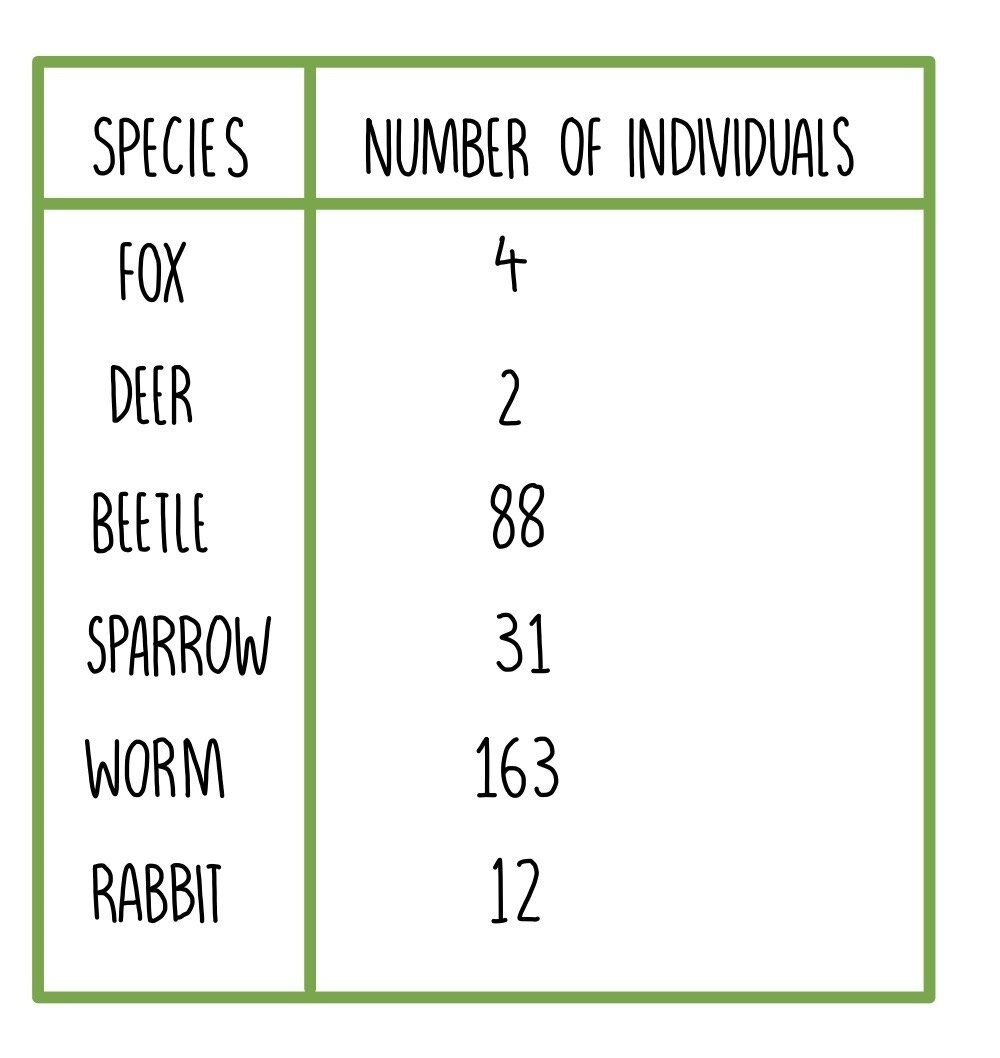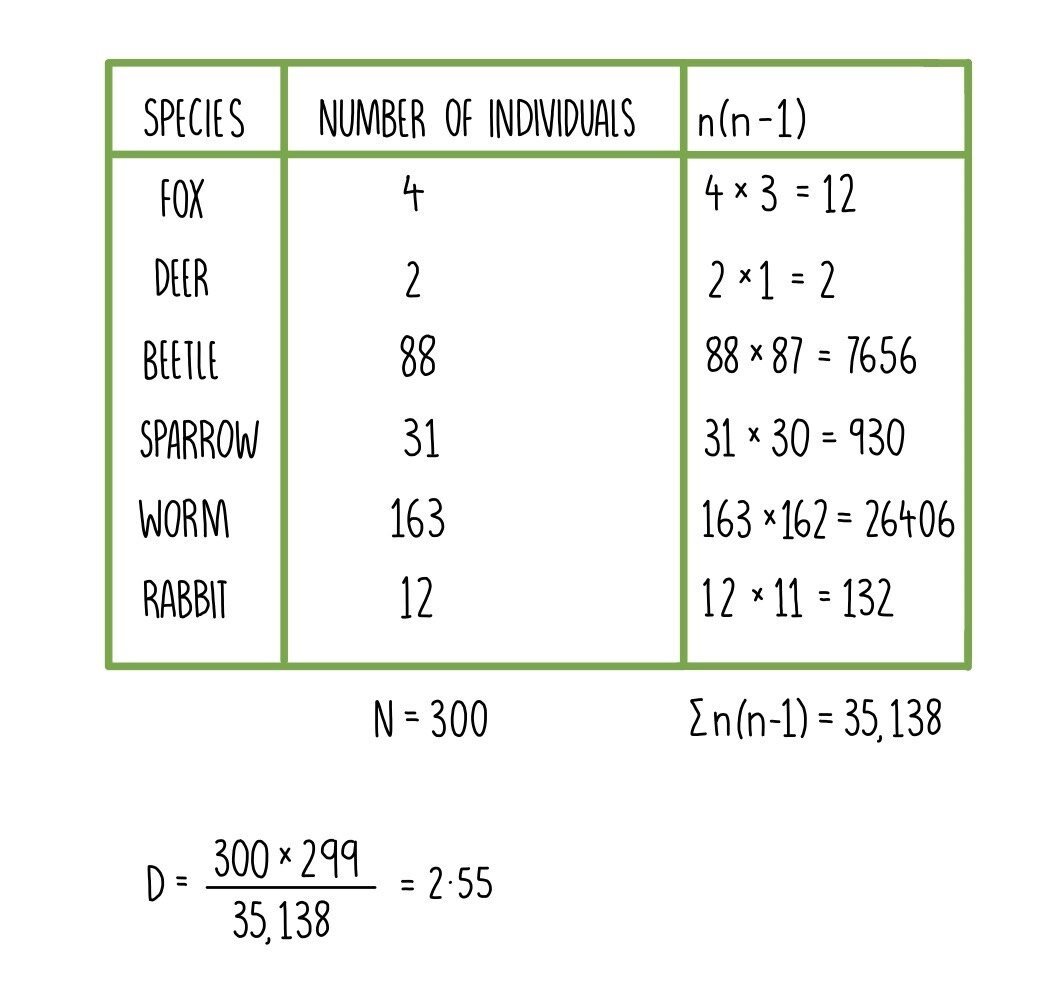Biodiversity
Ecology definitions
Biodiversity - the variety of living organisms in an area. High biodiversity means there are lots of different species.
Habitat – an area where an organism lives
Community – all of the different species in a habitat that interact with each other
Biodiversity
Biodiversity is defined as the variety of living organisms in a particular habitat. Habitats such as a tropical rainforest, which host an abundance of plant and animal life, have higher biodiversity compared to desert or arctic habitats. Biodiversity can be defined in different ways:
Species diversity - the variety of different species living in an area
Habitat diversity - the number of different habitats within an area
Genetic diversity - the number of different alleles within a population
Random and systematic sampling
Quadrats are square frames used to estimate population size.
Measuring the population size of a species by trying to count all of the individuals in the habitat would not only be pretty tricky but also considerably time-consuming. To save time, ecologists take a sample of the habitat and use that to estimate the size of the population in the whole habitat.
For species which don’t move, such as plants, quadrats are typically used. It is important that quadrats are placed randomly within the habitat to avoid bias. This can be done by using a tape measure to plot out the habitat as a grid and using a random number generator to plot coordinates. A large number of quadrats will be randomly placed throughout the habitat to ensure the data collected is reliable.
Sometimes it may be better to place the quadrats non-randomly - this is called systematic sampling. For example quadrats can be placed one next to each other along a transect. Systematic sampling is needed wherever there is an environmental gradient i.e. the abiotic factors change gradually from one end of the sample to the other.
Index of Diversity
Species diversity can be measured by calculating the Index of Diversity (D) of a particular habitat. It takes into account both the number of different species and the abundance of each species. The closer the value is to 1, the more biodiverse the habitat is. It is calculated using the following equation:
You should be given this formula in the exam so there is no need to memorise it! But you do need to remember what each component of the equation represents. N is the total number of organisms of all species living in that habitat and n is the number of organisms of a single species. Look at the example below to see how the Index of Diversity is calculated:
The table below shows the species present in a woodland habitat and their population size.
When calculating the Index of Diversity, the best way to organise your answer is to add another column to the table to work out square of n (population size of a single species) divided by N (total number of all organisms). We will then add all of these values together and subtract from one. As biodiversity increases, D also increases.
Measuring genetic diversity
Genetic diversity is a measure of the number of different alleles within a population. If a population has low genetic diversity, they may be unable to adapt to changing environmental conditions and are vulnerable to extinction. Isolated populations typically exhibit low genetic diversity (e.g. organism in zoos, or pedigree breeds of dogs or horses, for example).
Genetic polymorphism can be used as a measure of genetic diversity. Polymorphism is where a position on a chromosome (a locus) has two or more alleles. For example, the point on a chromosome where you find the gene for eye colour is polymorphic, because it is possible to have various different alleles at that position (i.e. for green, blue or brown eyes).
To calculate genetic diversity using polymorphic gene loci, use the following formula:
Human impact on biodiversity
Humans have contributed to the reduction of biodiversity in the following ways:
Deforestation – to make room for houses, roads or to use the wood for furniture or fuel. Since plants provide food and habitats to other animals, we’re also reducing the diversity of animals able to survive there. Indonesia’s forests are disappearing incredibly fast, at a rate of one football pitch every 25 seconds, now only 10% of the Indonesian rainforest remains.
Pollution – pollution from burning fossil fuels such as oil, coal and gas can remain in the air as particle pollutants or fall to the ground as acid rain. Acid rain, which is primarily composed of sulfuric and nitric acid, causes acidification of lakes, streams and sensitive forest soils, and can damage trees. In addition, chemical pollutants such as pesticides and herbicides leach into soils and watersheds. Some fish species, such as salmonids, require small freshwater streams to spawn. Polluted streams result in the abandonment of traditional spawning areas and ultimately in the loss of salmon populations. Species’ sensitivity to pollution is variable. However, many species are vulnerable to the indirect effects of pollution through the concentration of toxic chemicals in top predators of food chains.
Introduction of invasive species - an invasive species is one which is not native to a particular area and may have arrived in a new habitat accidentally (come on board a ship) or on purpose as a form of biological control. They may reproduce faster and be more likely to survive compared to the native species as they don’t have any natural predators in the area. They out-compete native species, resulting in a reduction in biodiversity. An example is the grey squirrel which has led to a reduction in the numbers of native red species in the UK.
Hunting and poaching – the overexploitation (killing more members of a species than can be replaced naturally) has reduced biodiversity. For example, the black rhino is at risk of extinction due to the trade in rhino horn. Hunting is not the only form of overexploitation – overfishing is the biggest cause of declines in ocean wildlife populations. Unsustainable fishing methods have meant that fishing vessels catch fish faster than they can be replenished. Bycatch, the capture of unwanted sea life while fishing for a different species is also a serious marine threat which causes the needless loss of billions of fish, along with hundreds and thousands of sea turtles and crustaceans.
Climate change – one of the consequences of climate change is extreme weather events, such as flooding due to melting sea ice. If a habitat becomes frequently flooded it may result in the migration of organisms from the habitat, reducing biodiversity in that area. Some species, such as plants, will not be able to move and may become extinct. An example of a species that has migrated as a result of climate change is the Sooty Copper butterfly which has moved 60 miles North due to increased temperatures. The movement of insects can have an effect on the prevalence of certain diseases in a habitat. For example, malaria-carrying mosquitos are moving to cooler regions and bringing malaria with them. Leishmaniasis, a deadly disease caused by a parasite which is carried by sandflies, is now affecting people in Northern Texas as the sandflies migrate north.
Impact of agriculture on biodiversity
Agricultural practices reduce biodiversity in the following ways:
Pesticides kill pests that feed on crops. This reduces biodiversity by killing the pests and reducing the food sources available to the animals that feed on them.
Herbicides kill weeds, reducing plant diversity and reducing the food sources available to primary consumers.
Removal of hedgerows – farmers remove hedgerows to convert smaller fields into bigger ones. This destroys habitats, removing shelter and food sources for small mammals and insects.
Deforestation or woodland clearance is carried out to increase the area of available farmland. Like hedgerow removal, it destroys habitats and reduces biodiversity by getting rid of shelter and food sources.
The original habitat is replaced with a monoculture – this is when only one type of plant is grown. This reduces biodiversity both directly (by replacing many species with just one) and indirectly (by reducing the number of food sources/habitats available to other species).
Maintaining biodiversity
Maintaining biodiversity is important for a number of reasons:
To protect keystone species – these are species which would cause an ecosystem to change dramatically if they became extinct. They are often predators and keep prey population sizes in check, but can also be organisms which modify the ecosystem (such as beavers building dams) or hosts (such as oak trees which provide shelter and food).
To maintain genetic resources which may prove valuable in the future. Many medicines are derived from plants and there may be plant species that have useful medicinal properties that we don’t know about yet. Other genetic resources include food, clothing, fuels and materials such as oils, wood and dyes.
To reduce soil depletion – growing just one type of crop (monoculture) depletes nutrients from the soil. This means fertilisers need to be used, which cost money. Growing more diverse plants can enrich soil and save money.
Areas of natural beauty promote tourism, which creates jobs and brings money into an area
We have an ethical responsibility to protect species for future generations
Plant life plays an important role in keeping global temperatures stable by absorbing carbon dioxide. Cutting down trees on a large scale is having an impact on global warming, with devastating consequences for human and non-human life.
Conservation
Conservation can either be in situ (protecting species in their natural habitat) or ex situ (placing them in a new environment).
In situ conservation could involve:
Giving legal protection to endangered species
Establishing protected areas e.g. nature reserves
Preventing the introduction of invasive species
Protecting habitats e.g. coppicing to conserve woodland
Ex situ conservation could involve:
Seed banks – seeds are frozen and stored to provide replacements if the plant becomes extinct.
Captive breeding – organisms are bred in captivity (e.g. in zoos) then returned to their wild
Relocating animals to safer areas e.g. where poaching is less of an issue
Botanic gardens – rare plants are grown for education and conservation purposes. Rare plants grown in botanic gardens may replace those that become extinct in the wild.
In situ conservation is less disruptive and is a more effective way at increasing population size. However, factors such as poaching, predation and disease are much more difficult to control in situ than ex situ. Ex situ is often less successful than in situ (particularly breeding programs) and can be expensive to maintain appropriate conditions for the organisms.
Countries cooperate internationally to conserve species:
Convention on International Trade in Endangered Species (CITES) is an agreement between countries to regulate the trade in threatened species. The agreement makes it illegal to kill or trade endangered species.
Rio Convention on Biological Diversity (CBD) is an international pact to share responsibility for conserving biodiversity. It aims to develop strategies and guidance to governments to use resources sustainably.
In the UK, local conservation agreements such as the Country Stewardship Scheme (CSS) protect wild areas. The scheme payed landowners to implement techniques such as growing hedgerows to increase biodiversity.







